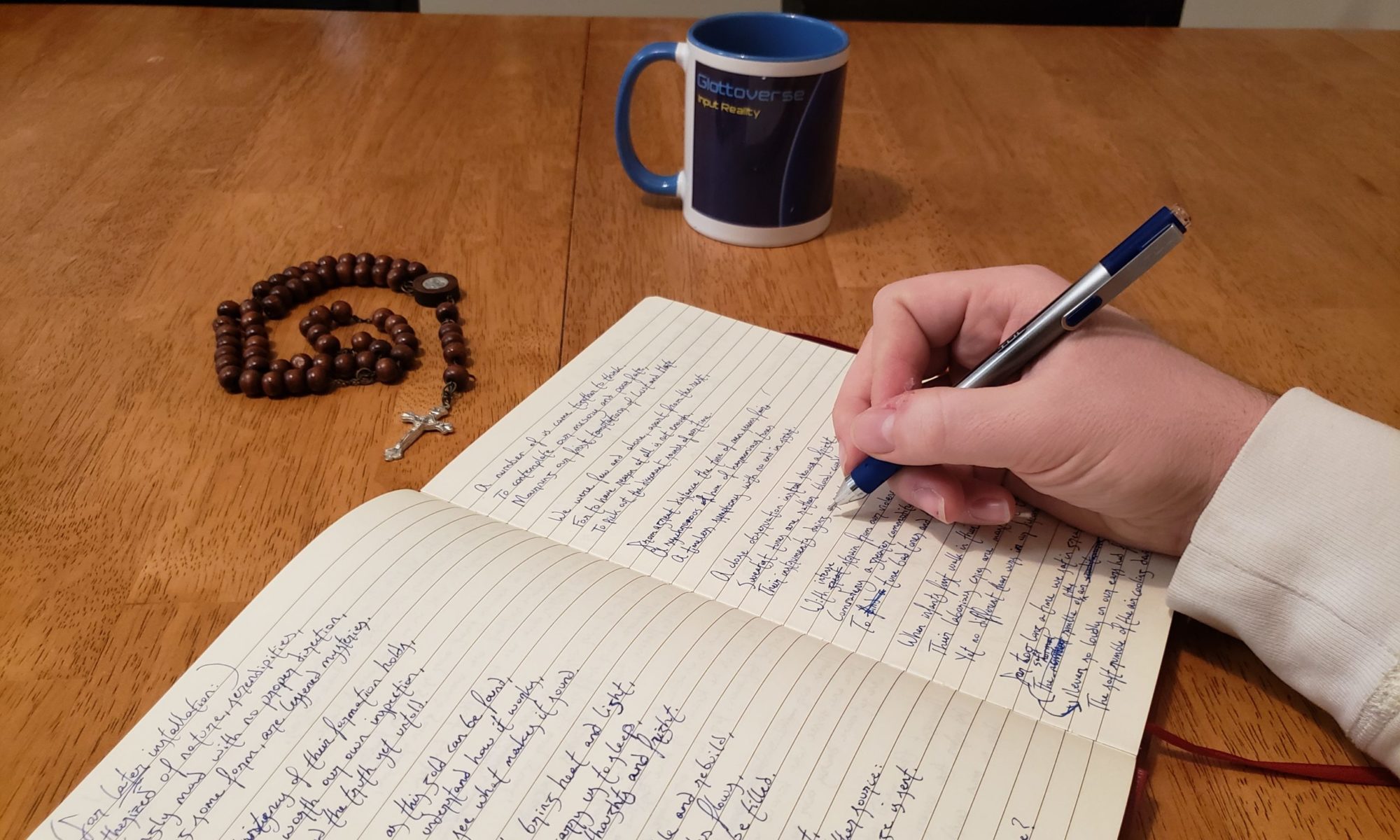I attend, as much as is practically possible, the Traditional Latin Mass. As a Roman Catholic I am obliged (quite happily, mind you) to weekly attend Mass, but as long as I go to a valid and licit Mass I have flexibility to attend wherever one is held. As a convert from non-denominational Christianity, you might believe that I would find something like the Traditional Latin Mass entirely appalling, but the truth is that it is incredibly attractive to me. An attraction borne of deep beauty.
Before investigating the reasons as to why I attend the TLM at all, first I must offer my reasons for attending any Mass to begin with. Compared with other groups of followers of our Lord Christ, the most Catholic of all beliefs is that our Lord left us with a particular gift of immense beauty before he sent out His apostles in His stead and was seated at the right hand of the Father. He instituted what is known as the Eucharist (Greek for thanksgiving), which is what non-Catholics know as being the Lord’s Supper. It is when the faithful eat bread and drink wine in memory of Christ’s death and resurrection, a symbol of the sacrifice itself. In Catholicism, however, there is a difference in belief. It is understood that the bread and wine become, during the consecration in the Mass, the actual body and blood of our Lord. As the Jews of the Old Testament consumed their sacrificial lamb after Passover, the Christians of the New Testament consume their own Sacrificial Lamb for the remission of sins, for sanctification, and for admittance to heaven.
This means that during the Mass, the faithful come into contact with heaven and with the eternal Christ, Himself, during the Mass. He Himself is present for others to see and consume. If you call to mind the significance of the literal presence of Christ in the Church, then a lot more about Catholicism makes sense. All of the reverent kneeling, music, and small symbols all take on a deeper aspect when you think that the person of their reverence is actually and legitimately present. If our Lord were not there, then it is a lot of show with no punch. But otherwise, it is like someone honoring the King of the Universe and they’re sure as heck going to be aware of such a fact. And when the King of the Universe says ‘eat of my flesh,’ I’m going to listen, and I’m going to receive it from the ecclesial authority that has maintained the centrality of the teaching of the Eucharist since its inception.
So that’s why I even attend Mass, and dare call myself Catholic. To receive the Eucharist is not something that any average ‘Christian’ can do, either. There are a whole host (Catholic joke, sorry) of consequences that arise from the consumption of our Lord through the Eucharist. When we consume the Eucharist, we are receiving His divinity, soul and flesh. Besides purifying us, this sacrament binds us together in Him. We are unified and not counted as separate. When Christ looks upon His church, He will see those who share a literal part in him. All of the physical churches of the world are then brought together by these and other singularly Catholic sacraments. Historically this is the significance of an excommunication. It is the power of Church authority to tell someone they are living an impure life and need a radical change before they can once again be admitted into the Body of Christ.
All Catholic Churches, singularly headed by the Bishop of Rome, believe and profess this to be true. It is the source of our unity and it is what binds our worldly organization together. Many Orthodox Churches also profess Christ to be literally present in the Eucharist, but do not submit to any singular Papal authority. That, however, is a different book to read about.
For me, this Eucharist is central to my relationship with God and it orients my worship of God here on Earth. What a miracle to claim and profess: that the God man can be literally and manifestly present in a form not explicitly human. So, then, I don’t take my Mass setting lightly. Whenever it is time for Mass, I orient myself as reverently as possible. While Christ’s sacrifice and resurrection is at once cause for us to jump for joy, the gift of the Eucharist is not everything. When we eventually go to heaven we will be gifted the immediate presence of God and all of our needs will be met in that singular presence, and the Eucharist is a temporal, mitigated presentation of something similar. For this season of human existence we are gifted the Eucharist, a faith in our Lord not confirmed yet by our immediate senses. And for those that have faith in that now will have faith in His later immediate presence when He comes again. So, then, the Mass is solemn as much as it is joyful, looking forward to the second coming.
Currently there are a couple of forms of the Mass to be seen, the Ordinary Form (OF) and the Extraordinary Form (EF). The OF is said in the local language where the Mass is being held and tends to feature more variance in choice of Music. It was a restructuring of the Mass in the late 1900s after the Second Vatican Council. The EF is said largely in Latin and relies heavily on the use of Gregorian Chant, Polyphony, and old Hymns and uses the rubric of the Mass right before the shift happened (from the early 1960s). The OF is entirely valid and licit so long as the rubric is completed in its entirety, and so Christ is present as much as He is in the EF, but there’s a lot to be said as to whether it can easily be felt that Christ is present in the OF.
Imagine, for a second, that you went to visit the Queen of England. Visiting royalty is a bit of a big deal, so you want to make sure you’re prepared. You learn about the pattern of visiting the Queen and you dress a little bit too nicely. You learn about the customs of the Buckingham Palace and make sure to follow them to a T. You practice what you’re going to say over and over again in your head. There is music that meets the tone of the occasion. After all of this preparation, though, you show up in England and you are told to meet the Queen, informally, down at a local pub over a couple of beers. Did you still meet the Queen? Of course. Did you still converse with her about the same content? Most likely. Was it underwhelming? Yeah! Probably!
The OF was designed around making the Mass more accessible and easier to understand. It caters more to the individuals present, breaking down any barriers that might keep the lay faithful from fully comprehending what is happening at any given point. Done properly, the OF can be very beautiful, but for me I find it has limitations. In many ways it can be like meeting the Queen at the pub instead of in a royal setting at the Buckingham Palace. As I heard recently in a discussion between Matt Fradd and Father Michael O’Loughlin, the OF can be a difficult place to search out and find the reverence towards the majesty of Christ and His tradition through the Church (even though it is still there). In many ways it feels like the removal of ‘barriers’ was really a removal of mystery and a removal of beauty.
The EF, for me, maintains a more full beauty and mystery properly due to our Lord Christ. I specifically have been enchanted by the Gregorian Chants so intricately involved in the yearly structure of the Church from Advent to Advent. I myself even began helping chant for the EF because of how beautiful I find it. When at the EF Mass, I don’t have to look hard to find reverence for Christ. I feel that my Christian brothers and sisters are, in unison, acknowledging the true depth of the mystery of our Lord’s presence. Furthermore I feel that as in a participant of the EF Mass, I am doing my fullest to participate and honor my God and King.
A key element of the EF is the use of Latin. The EF is oftentimes referred to as the Traditional Latin Mass (TLM). For some this feels alienating, especially when the rubrics allow for Mass to be said in the local language in the OF. Of course with my affinity for languages I have a certain bias towards doing things in an alternative language other than English, but in this case there is a fairly objective reason to find the Latin beautiful. The Roman Catholic Church, centered in its Roman identity, uses the language of Latin as a centralizing language. Prior to the adjustments after Vatican II, Latin was the singular language used in all Roman Rite Churches – meaning that all Catholic Masses were precisely the same, regardless of the locale where the Mass was being said. By using Latin as the language of the Mass it aids in the universal identity and unity of the Catholic Church. The Mass is still this same way from place to place, as the rubrics are the same, but now individual languages are used instead, decentralizing the element of language. For me, participating in the Latin Mass gives me not just a connection the Church at large, as the OF does, but it also roots me in the tradition, knowing that I am saying and participating in the same Mass as many of my Catholic priors. I easily feel connected to Catholics of time past.
Most importantly, the TLM, the EF, inherently contains more respect for how the Eucharist is consumed by its attendants. In the OF the lay faithful have the option to receive directly on their tongue, usually while standing, or in their hand for them to put in their mouth themselves. In the EF, the lay faithful only have the option of kneeling at an altar railing to receive the Eucharist directly on the tongue. Some, as I, have taken to only receiving the Eucharist in the OF while kneeling. Worship is all about posture of the person and posture of the soul. Kneeling is an inherently more reverent way to acknowledge the Lord, and while it is possible in the OF, it is systematic in the EF. In this way, also, there is an increased reverence for the Eucharist and for the Mass.
I do not have the luxury of attending a weekly TLM. As of now I only attend it once a month, as it is the closest TLM by a few hours. Every time I go, though, I can say that it is the most fulfilling form of the Mass I have experienced. I don’t feel like I bumped into our King at the pub. I feel like I bowed and worshipped my King in a magnificent setting. In Christian circles, especially protestant ones, there is a mind to discuss witnessing, showing Christ’s love to others and inspiring them to follow Him. In my mind and within my own tradition of the Latin rite, there is no better way to revere and worship Christ. Similarly there is no better witness to the Catholic faith than the Traditional Latin Mass, which is shrouded in beauty and attractive mystery.

P.S. If you are Eastern Catholic or Orthodox, then please know I have a respect for your own traditions, I just didn’t really have the space to address them within the scope of my article.

